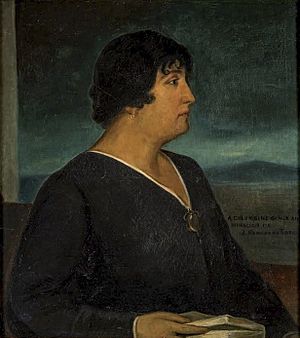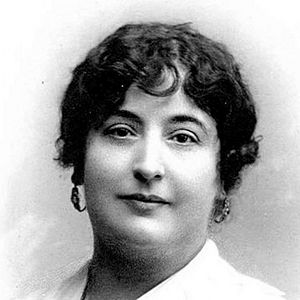Carmen de Burgos facts for kids

Carmen de Burgos y Seguí (born December 10, 1867 – died October 9, 1932) was an important Spanish journalist, writer, and translator. She also worked hard for women's rights. People knew her by many pen names, like Colombine, Gabriel Luna, and Marianela. She is remembered as a modern writer who helped change how women were seen in society.
Early Life
Carmen de Burgos was born in Almería, Spain, in 1867. Her family was middle-class. Her father owned a gold mine. Both her father and uncle helped manage the Portuguese vice-consulate in Almería. Her mother had a good amount of money from her family.
Becoming a Writer and Activist
Carmen married Arturo Asterz Bustos when she was young. He was a poet and writer. They were married for 17 years and had four children, but only one survived. Carmen soon realized she needed to work to support herself.
In 1898, after her infant son died, she decided to go to college. She wanted to become a teacher. She quickly earned her teaching certificates. By 1900, she was qualified to teach other teachers! This meant she could always find work.
With her new skills, Carmen and her daughter left her husband. They moved to Guadalajara. There, she wrote her first book. During this time, she learned how to write for a living. She became independent and believed strongly in women's freedom. Carmen saw herself as a feminist. This meant she supported equal rights for women.
Carmen wrote many novels that were popular at the time. Her books often talked about important legal and political issues. She brought up difficult topics like gender roles and women's rights. She showed how traditional ideas about women's education didn't fit with modern life. In 1904, she even led a campaign to make divorce easier to get in Spain.
Breaking Barriers
In 1906, Carmen de Burgos made history. She became the first professional female journalist in Spain. She worked as an editor for a newspaper in Madrid called Diario Universal. She also became the first president of the International League of Iberian and Latin American Women. This group worked to improve the lives of women in Spain and Latin America.
Later, during Franco's time as leader, Carmen de Burgos was removed from history books. But after Spain became a democracy again, her important work was recognized. She was put back into the history of women's rights in Spain.
Selected Works
Carmen de Burgos wrote many different kinds of books and articles. Here are some of her most well-known works:
- Essays and other works
- Ensayos literarios, 1900.
- Álbum artístico literario del siglo XX, 1901.
- Notas del alma, 1901, (a collection of popular songs)
- El divorcio en España, 1904. (About divorce in Spain)
- La mujer en España, 1906. (About women in Spain)
- Por Europa, 1906 (About Europe)
- La voz de los muertos, 1911 (The voice of the dead)
- Leopardi, 1911
- Misión social de la mujer, 1911 (The social mission of women)
- Cartas sin destinatario, 1912 (Letters without a recipient)
- Al balcón, 1913 (To the balcony)
- Impresiones de Argentina, 1914 (Impressions of Argentina)
- Confidencias de artistas, 1916 (Confessions of artists)
- Peregrinaciones, 1917 (Pilgrimages)
- Mis viajes por Europa, 1917 (My travels through Europe)
- ¿Quiere usted comer bien?, 1917 (Do you want to eat well?)
- Fígaro, 1919
- La Emperatriz Eugenia, 1920 (Empress Eugenia)
- Hablando con los descendientes, 1929 (Speaking with descendants)
- Gloriosa vida y desdichada muerte de D. Rafael del Riego, 1931. (Glorious life and unfortunate death of D. Rafael del Riego)
- Amadís de Gaula, s.a.
- Novels
- Los inadaptados, 1909 (The unadapted)
- La rampa, 1917 (The ramp)
- El último contrabandista, 1918 (The last smuggler)
- Los anticuarios, 1919 (The antique dealers)
- El retorno, 1922 (The return)
- La malcasada, 1923. (The unhappily married woman)
- Los espirituados, 1923. (The spirited ones)
- La mujer fantástica, 1924. (The fantastic woman)
- El tío de todos, 1925. (Everyone's uncle)
- Quiero vivir mi vida, 1931. (I want to live my life)
- Los anticuarios.
- Short stories
- Ensayos literarios, 1900.
- Alucinación, 1905 (Hallucination)
- El anhelo (The longing)
- El abogado (The lawyer)
- El artículo 438 (Article 438)
- Cuentos: El tesoro del castillo (Stories: The castle's treasure)
- Cuentos de Colombine (Colombine's stories)
- En la guerra (In the war)
- Honor de familia (Family honor)
- Translations
- Historia de mi vida (muda, sorda y ciega), 1904 (History of my life (mute, deaf and blind))
- La guerra ruso-japonesa, 1904. (The Russo-Japanese War)
- La inferioridad mental de la mujer, 1904. (The mental inferiority of women)
- Loca por razón de Estado, 1904. (Crazy for reasons of state)
- Los Evangelios y la segunda generación cristiana, 1904 (The Gospels and the second Christian generation)
- La Iglesia cristiana, 1905 (The Christian Church)
- Diez y seis años en Siberia, 1906. (Sixteen years in Siberia)
- En el mundo de las mujeres, 1906. (In the world of women)
- El rey sin corona, 1908. (The king without a crown)
- La conquista de un Imperio, 1911. (The conquest of an Empire)
- Los misterios de la india, 1911. (The mysteries of India)
- La corona de olivo silvestre, 1911-1913. (The wild olive crown)
- Fisiología del placer, 1913. (Physiology of pleasure)
- Las mañanas en Florencia, 1913 (Mornings in Florence)
- Las piedras de Venecia, 1913. (The stones of Venice)
- Las siete lámparas de la arquitectura, 1913. (The seven lamps of architecture)
- Los pintores modernos. El paisaje, 1913. (Modern painters. The landscape)
- Cuentos a Maxa, 1914. (Stories for Maxa)
- El reposo de San Marcos. Historia de Venecia, 1915. (The rest of Saint Mark. History of Venice)
- La Biblia de Amiens, 1916. (The Bible of Amiens)
- La decisión, 1917. (The decision)
- Una idea de parisiense por página, 1917. (A Parisian idea per page)
- La perseverancia, 1919. (Perseverance)
- Defnis y Cloe, 1910.
- Los últimos filibusteros, 1913. (The last buccaneers)
- La princesa muda, s.a. (The mute princess)
- El tío Geromo (Crainqueville). (Uncle Geromo)
- Cuentistas italianos. (Italian storytellers)
- Translations into English
- Take Six: Six Spanish Women Writers, edited and translated by Kathryn Phillips-Miles and Simon Deefholts, Dedalus Books, 2022: This book includes some of her stories translated into English.
See also
 In Spanish: Carmen de Burgos para niños
In Spanish: Carmen de Burgos para niños


